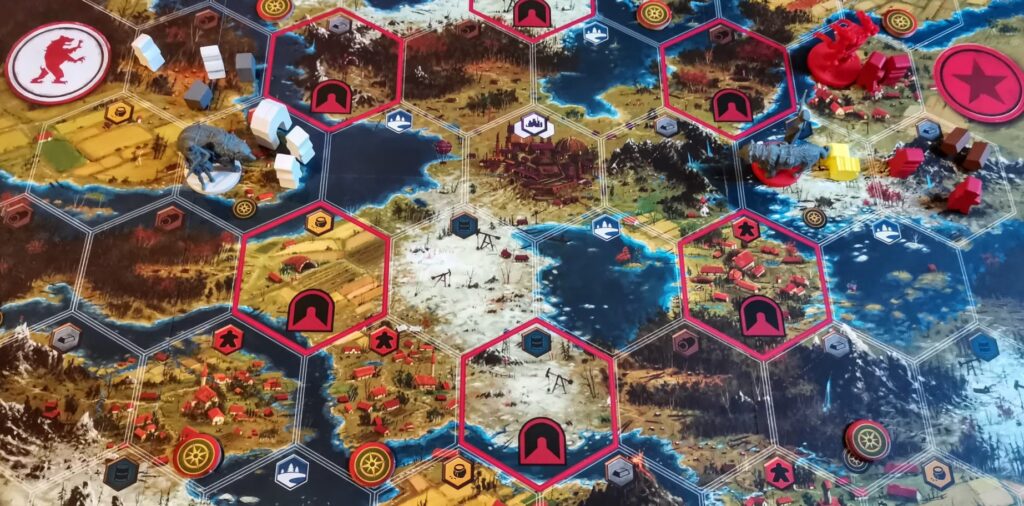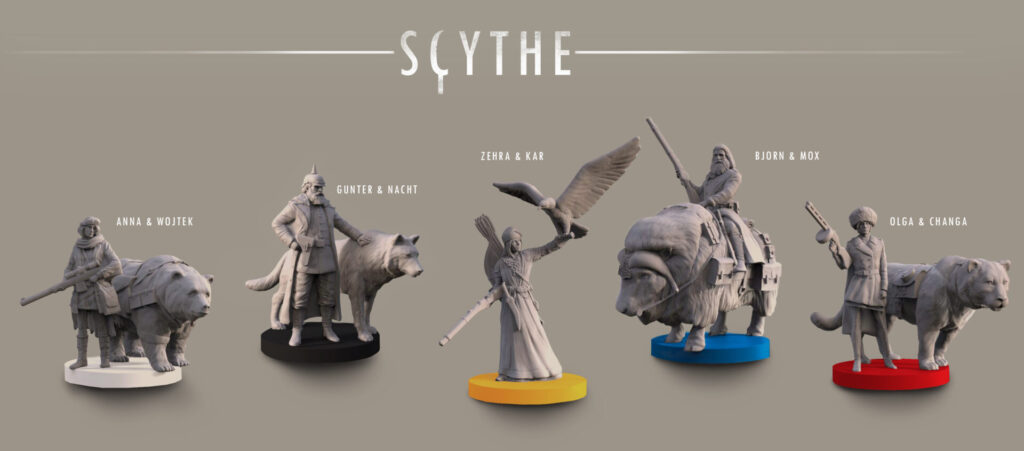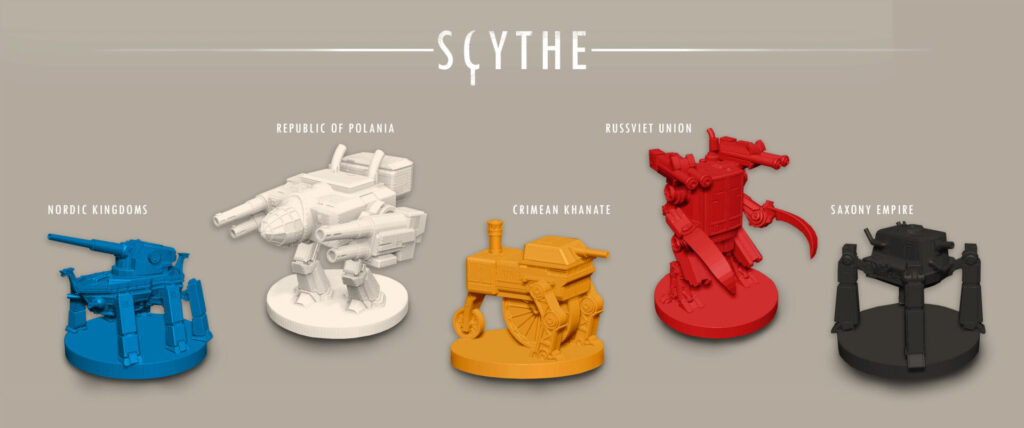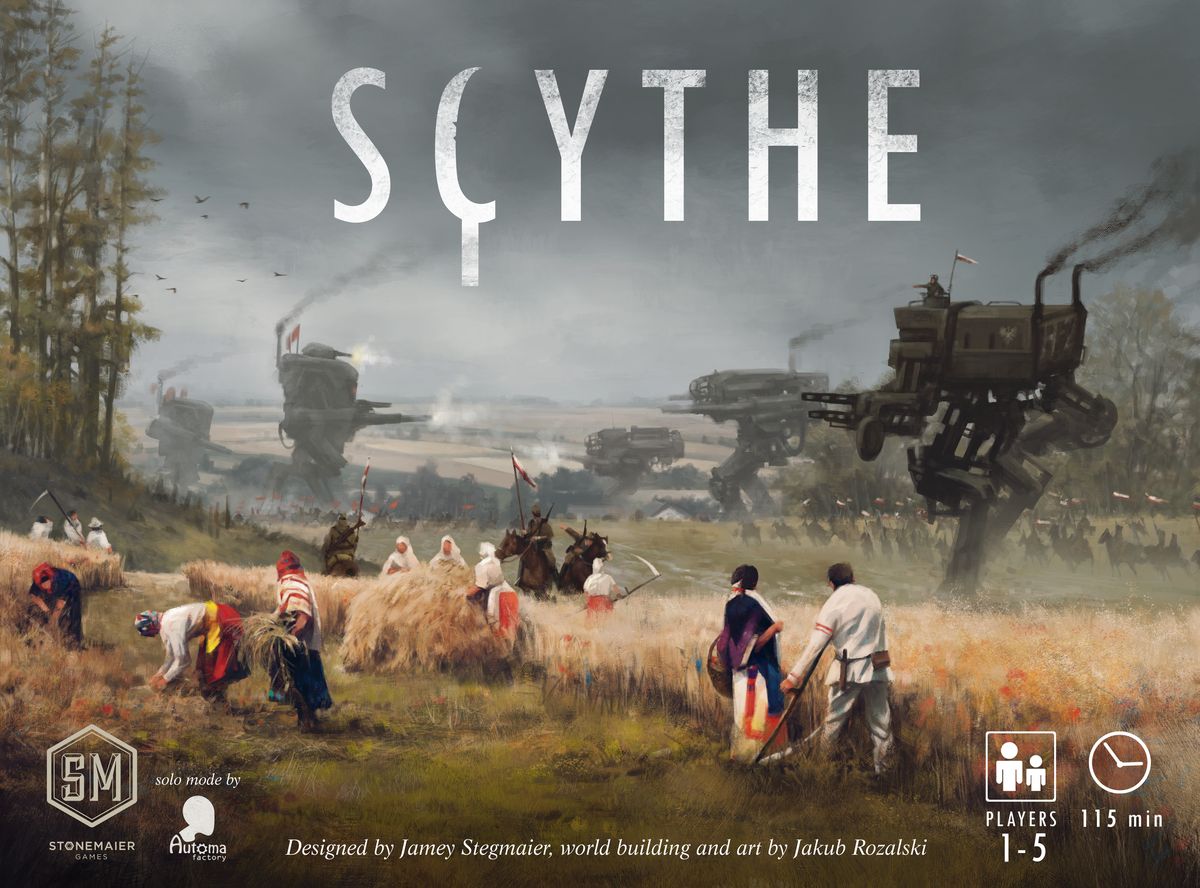Scythe is Stonemaier Games’ Euro-in-mechs-clothing game from 2016. It’s a game that’s been riding high in the BGG charts since its release, so it’s about time I gave it a proper review. Scythe in set in an alternate-history 1920s, in a fictitious version of Eastern Europe. It’s a world where farming and war are at the heart of what the population works for every day, and a world where five battling factions strive to control the land, money and populace.
The artwork on the box by Jakub Rozalski is iconic now. The sight of dieselpunk mechs battling in fields, while workers tend their crops is really evocative, but it can set people up for a game that’s not entirely what they’re expecting. Rather than being a game about gigantic mechanical creatures duking it out on top of someone’s turnips, Scythe is a Euro game. It’s an area control game, a game of choosing routes to victory, and upgrading your abilities in order to get there.
There is strength in unity
The hex-based board and plastic mech and leader minis really belie the type of game Scythe is. Combat is a really small part of the game. Instead, the threat of combat is what drives the game. It’s about posturing and showing off what your military is packing. It’s a giant, mechanical dick-waving competition. Instead of conflict, the heart of the game lies in resource production and management.

Players are given a faction to control, each with its own unique powers and bonuses. Along with their factions – which include their unique mechs and leader mini – players are assigned player boards. The player boards hold buildings and upgrade cubes, and also control which actions you can carry out. The four different spaces on the board have both top and bottom actions, and the way those actions are paired vary from board to board. It ensures a really good variety in setup, and keeps experienced players on their toes.
The various actions get your workers moving from hex to hex, and exploiting the land’s natural resources for the good of the motherland. The mechs are there to offer support and protection. They can carry workers and resources around the map, keeping them safe from potential aggressors. Once in a while though, with so much titanium testosterone stomping around, things are bound to kick-off.
Scrap metal
Combat is a pretty low-key affair in Scythe. Each player gets a dial to represent their strength, and you can spend your accumulated power from your power track. You can also attach a face-down combat card which has a value to add to the strength. The dials get revealed, cards flipped, and to the victor (i.e. the person with the most power), the spoils. They keep whatever resources were on that space, and the loser sends all their units from the contested hex back to their home space, to lick their wounds. The winner also places a star on the triumph track, but more on that later.

Controlling the resources is the key to the game. It’s how you’ll build and deploy your mechs, and how you’ll add buildings to the board. Getting your buildings onto the board not only helps you control the map, it also unlocks whatever bonuses were lurking under them on your player board. I love getting two for the price of one.
The other really useful thing your hard-earned resources can do is upgrade your player boards. There are lots of cubes sitting in the socketed spots on your board (side note: I love a socketed board, and these ones are great), and upgrading moves a cube from on top of a green space – green gives you stuff – and places it into a red space. Red spaces are costs, so upgrades are a two-for-one – increase bonuses while decreasing costs. Yay for optimisation!
Star light, star bright
I mentioned stars above, and stars are the key to victory. Much like other Jamey Stegmaier game designs, Scythe doesn’t have a set number of rounds in the game, instead the game ends similarly to the way Euphoria did before it. Players are awarded stars for completing certain feats during the game, those stars go on the triumph track.
Once one player places their sixth star on the track, the game ends, and the exciting job of tallying the scores can start. It sounds like something that’s easy to keep track of, but it isn’t, as there are nine different categories of achievement that let you place stars. Nine!

Basically, you’ve got to have eyes in the back of your head playing Scythe. Or is it eyes on stalks? Whatever, you need extra eyes. As well as deciding on the way you want to play the game, you simultaneously need to keep an eye on what every other player is doing too. Once two or three players have got five stars on the board, the friendly chat stops, and everyone suddenly becomes hyper-vigilant. What sort of things are they collecting? Is that person moving troops closer to that space? How many structures have they got left to place? I SEE YOU!
I’m a big fan of this kind of end-game trigger. There’s nothing hidden from anyone; all of the information anyone needs is there on the table, sat between you all. It gives you opportunities to try to delay proceedings, in order to get those last few things you need. You’ll see players trying to influence each other, under the guise of fighting a collective enemy, but secretly with designs on their own victory. It’s absolutely delicious!
Final thoughts
There is so much I haven’t even touched on in this review. Popularity. Encounters. Objective cards. The mysterious factory in the middle of the board that everyone wants to get to. Digging tunnels to scoot around the map like mechanised moles. The strange fact that these factions can build enormous robots but can’t cross rivers easily… seriously, what’s that about? There is so much going on in a game of Scythe, that every time you play it, the game will be completely different to the time before.

Scythe is really daunting the first time you play it. It looks incredible set-up on the table, with all the different forces surrounding the map, ready to try to stake their claims. But when it comes down to it, it’s a medium-heavy Euro with some area control. That shouldn’t come across as a bad thing either, that’s a great thing in my books. It just means those first games are often jarring, time-consuming teaches. Especially if the players come to the game expecting hardcore mech-on-mech fisticuffs. You just need to guide your group through that first play.
The production is top-notch, the artwork throughout is absolutely beautiful, and there’s a huge amount of game in the box for the money. Despite so much variety in factions, objectives and player boards, the game is wonderfully balanced. I haven’t found a combination yet of faction and board that feels overpowered (certain combinations are named and banned in the rulebook), and that’s over the course of a lot of plays of the physical and digital versions of the game. If you do get tired of the base game, there’s plenty in the form of expansions, and a modular board to keep things fresh.

Scythe is five years old now, but don’t let that fool you into thinking it’s been superseded by something better. It hasn’t. If you’re looking for a medium-heavy Euro with a solid solo mode (by Automa Factory), oodles of replayability, and one that’s absolutely dripping with theme, you really can’t do any better than Scythe. It’s a modern masterpiece, and one that everyone should own and play.
Review copy kindly provided by Stonemaier Games. Thoughts and opinions are my own.
Scythe is available from our sponsor – Kienda. Sign-up using this link to get 5% off your first order over £60.

Scythe (2016)
Designer: Jamey Stegmaier
Publisher: Stonemaier Games
Art: Jakub Rozalski
Players: 1-5
Playing time: 90-120 mins
